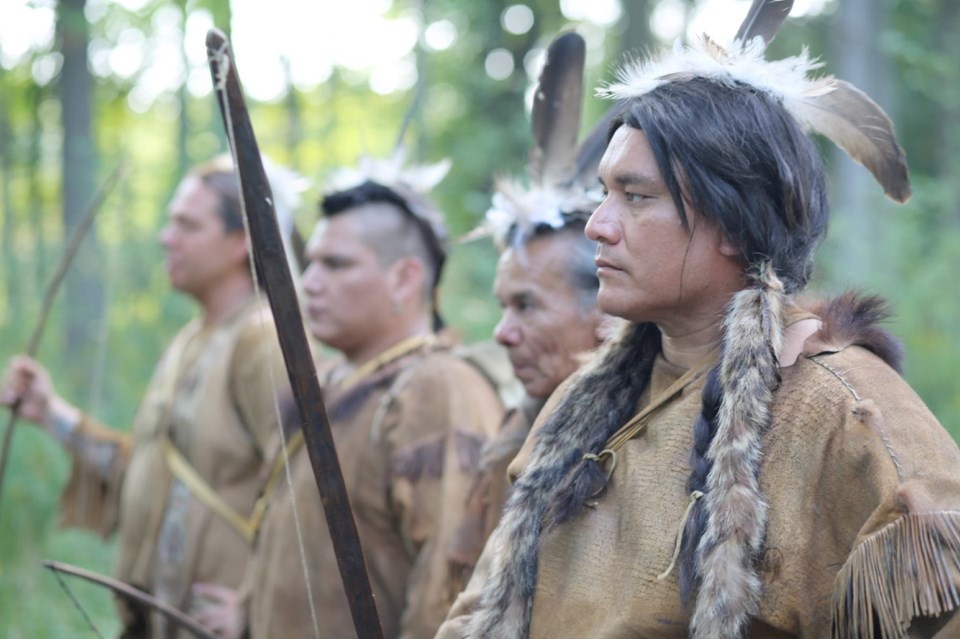ON SCREEN
What: 1491: The Untold Story of the Americas Before Columbus
Where: APTN
When: Premières tonight, Nov. 8, 7 p.m.
When Victoria-based filmmaker Barbara Hager is asked how long it’s been since she started working on 1491: The Untold Story of the Americas Before Columbus, she flashes back to a moment in 2011.
She was visiting the Amherst, Massachusetts, home of Charles C. Mann — author of the bestseller on which the miniseries is based — when she noticed the author’s dining-room table was shaking.
“I realized it was an earthquake, and I thought: ‘Oh, that sounds ominous.’ I thought there was a message in there somewhere, that we were going to be in trouble,” Hager recalled with a laugh.
With a $4-million budget, the miniseries, based on Mann’s 1491: New Revelations of the Americas Before Columbus — which premières on APTN tonight — isn’t just the most expensive production Hager has helmed.
It is also the capital region’s biggest homegrown docu-drama series, employing at least 50 locals who appeared on-camera or worked behind the scenes as part of the project’s 400-member crew worldwide.
“We didn’t realize it was 400 overall until we did the closing credits,” said Hager, whose aim was to accurately detail the history of Indigenous people in the Americas before and after 1492.
All key creative contributors to the series, which combines science, history and archaeology, are also local.
While 1491 explores a story most often told from the point of view of European settlers and non-Indigenous scholars, the series is produced, directed and written by Indigenous Canadians and features an Indigenous cast of actors and cultural leaders who provide context.
Bolstered by input from historians, archeologists, cultural experts and scholars, most of whom have Indigenous ancestry, the series dispels long-held theories — for instance, that before contact with Europeans, Indigenous peoples were largely nomadic, and not as advanced as other civilizations at the time.
After filming in Taos Pueblo, New Mexico, Machu Picchu in Peru and Mexico’s Yucatan, crews returned to Victoria, standing in for locations in Chile, Argentina, the Arctic and the West Coast.
The cameras rolled at Mount Douglas, Goldstream Park and McKenzie Bight, where a significant arrival-in-the-Americas scene features a dugout canoe created by the art department. The cedar bark canoe was later used as a prop in an episode of the Murdoch Mysteries shot here last month.
Hager, who is Cree/Métis, wrote the series with Marie Clements, who is Métis, and co-directed with Lisa Jackson, who is Anishinaabe, during an adventure that saw crews filming throughout North and South America.
The series was produced by Hager’s Aarrow Productions and Animiki See Digital Production, with Victoria-based executive producer Pat Ferns drawing upon his expertise with large-scale projects such as Captain Cook: Obsession and Discovery and Darwin’s Brave New World to shepherd the project.
Other notable credits include composer Russell Wallace (Lil’wat), production designer Teresa Weston, costume designer Carmen Thompson (Nuu-chah-nulth), director of photography Bob Aschmann, editors Michael Clark and Tyler F. Gamsby and narrator Dr. Evan Adams (Tla’amin).
Having a predominantly Indigenous crew adapt a book written by a non-Indigenous author was not without its challenges, said Hager, adding that it was such a long process, she sometimes felt it would never end.
While Mann’s book provided about 30 per cent of the docu-drama’s storyline, the creative team had to research 40 new topics, split into eight episodes in which dramatizations and documentary footage are intercut.
“I feel like I just wrote eight books, not eight episodes,” said Hager, whose material was rigorously checked for authenticity by cultural advisors on Indigenous matters, which protracted the process.
“We waited 525 years to tell our own stories, so I thought: ‘What’s another five or six years?’ ” Hager said with a laugh.
In keeping with her production philosophy, the shoot was as much of an educational cultural experience as the series itself, with non-Indigenous craftspeople working with predominantly Indigenous crews.
“In every place we’d have welcomes, where an elder would come in and do a song or a blessing,” Hager said.
“We met a lot of people from different First Nations communities wherever we went.
“Our crew learned a lot about diversity all over North and South America.”
1491 is also slated to air on other networks globally, including in Australia, the Czech Republic and Germany, but it’s far from over, Hager said.
“It’s only beginning, because now schools and universities and libraries are contacting us,” said Hager, who hopes to launch a charitable foundation and provide free copies to First Nation schools and friendship centres.

-thumb.png;w=120;h=80;mode=crop)

